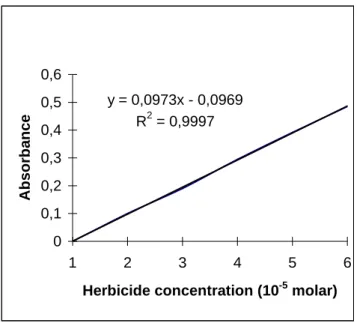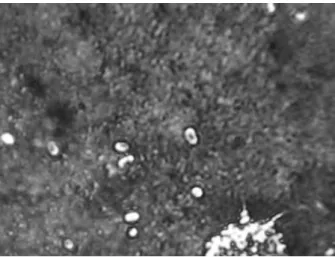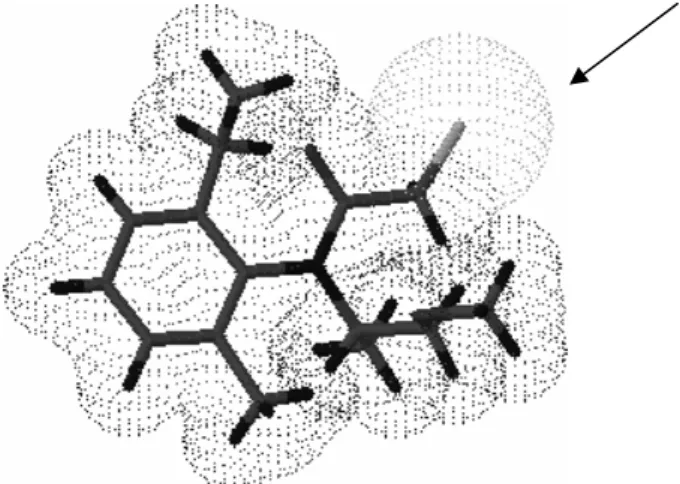Vol.50, n. 1 : pp.153-159, January 2007
ISSN 1516-8913 Printed in Brazil BRAZILIAN ARCHIVES OF
BIOLOGY AND TECHNOLOGY
A N I N T E R N A T I O N A L J O U R N A L
Selection of Microorganisms Degrading S-Metolachlor
Herbicide
Paula Fabiane Martins1, Camila Ortiz Martinez1, Giselle de Carvalho1, Paulo Irajara Borba Carneiro2, Ricardo Antunes Azevedo3, Sônia Alvim Veiga Pileggi1, Itamar Soares de Melo3 and Marcos Pileggi1*
1Departamento de Biologia Estrutural, Molecular e Genética; Universidade Estadual de Ponta Grossa; Ponta
Grossa - PR - Brasil. 2Departamento de Química Geral; Universidade Estadual de Ponta Grossa; Ponta Grossa -
PR - Brasil. 3Departamento de Genética; Escola Superior de Agricultura Luiz de Queiroz; Universidade de São
Paulo; São Paulo - SP - Brasil. 3Embrapa Meio Ambiente; Jaguariúna - SP - Brasil
ABSTRACT
The aim of this work was to study herbicide degradation through selected microorganisms from humus and soil subjected to different plantation systems. The following bacterial species were identified: Klebsiella pneumoniae pneumoniae GC s.B strain 1, Pseudomonas alcaligenes, Enterobacter aerogenes GC s.A and Klebsiella pneumoniae pneumoniae GC s.B strain 2. Growth studies yet suggested the possibility of a very long lag phase. Although, culture with the herbicide presented biofilm formation and there were color changes in the herbicide that could have interfered with the espectrophotometry readings. After 5 days of incubation at 35ºC, the difference in the concentration of herbicide was 14.42% on average and after 10 days, 35.01%.
Key words: Bioremediation, biodegradation, S-Metolachlor, herbicide
* Author for correspondence
INTRODUCTION
With the modernization of agriculture in the 60's, a massive use of agrochemicals, fertilizers and machinery began, aimed at improving field productivity. These goals have been achieved, although the side effects of this situation include an intense and abusive utilization of these chemicals, creating many kinds of problems (Fay et al., 1997). The agrochemical impact on the environment is clear, but measuring its effects is difficult. Residues can cause damage and bring about disease to plants in a rotation culture system in a cumulative manner, restricting microbial growth (Frighetto, 1997; Rickman et al., 2002). For these reasons, human health and the
representing a powerful source of groundwater pollution (Liu et al., 2001; Scribner et al., 2000; Ferrer et al., 1997; Rodrigues and Almeida, 1998). Generally, acetanilide residues and their metabolites are common in aquifers in close proximity to agricultural soils where these herbicides have been applied (Stamper and Tuovinen, 1998). Acetanilide biodegradation is a very important factor for its elimination in aerobic and anaerobic environments. Hydrolysis is not as important in soil and water pH conditions, while adsorption in argil and organic matter probably retards the biodisposability (Stamper and Tuovinen, 1998). These herbicides are somewhat resistant to photodecomposition (Humburg et al., 1989). In several organisms, the greatest factor of acetanilide transformation is detoxification by glutation-S-transferase (GST) (Stamper and Tuovinen, 1998; Zablotowicz et al., 1995;
Hammond et al., 1983). Despite this,
microorganisms do not easily metabolize aromatic fragment (Liu et al., 1987), raising a serious environmental concern.
Until now, pure bacterial cultures able to metabolize acetanilide or its sulfonate derivatives have not been described in the literature. Tiedje and Hagedorn (1975) were able to isolate a soil
fungus, Chaetomium globosum, which could
partially transform alachlor into several
metabolites, but the aromatic ring remained intact. About 6 to 14% of the alachlor herbicide was
metabolized by Ceriporiopsis suvermispora,
Phelebia tremellosa e Phanerochaete
chrysosporium, after 122 days of incubation (Ferrey et al., 1994). The low degree of enzymatic degrading of this herbicide suggests that a co-metabolism hypothesis might be possible. Chaetomium globosum fungus is able to utilize 55% of the Metolachlor molecules as a unique carbon source, in a 6 day period, without altering the aromatic ring, with a high level of byproduct production (Saxena et al. 1987; Liu et al., 1989). Other bacteria and fungi capable of metabolizing Metolachlor were isolated (Saxena et al., 1987; Liu et al., 1989), but the break down of the ring has not been successfully obtained as yet. Propachlor was the only herbicide of this group passive enough to be completely metabolized (Villarreal et al., 1991).
fact that its degradation would be essentially performed by microorganisms, constituted the basis of this work. The following experimental tasks were performed on soil microorganisms from herbicide free humus and direct and conventional plantings soils subjected to S-Metolachor treatment: isolation in selective culture media, capsule coloration, halo determination in solid media culture, biochemical identification and the monitoring of herbicide concentration using ultraviolet spectrophotometry.
MATERIALS AND E METHODS
Sampling
The soil samples used to isolate the microorganisms were humus (from Ascomycota) without the herbicide and direct and conventional plantings soils treated with S-Metolachor herbicide. The source of the herbicide was a trade brand called Dual Gold at a concentration of 960 g.L-1. Commercial humus and agricultural sandy-argil soils were obtained in Ponta Grossa city, Parana State, Brazil. The pH of these soils was determined.
Tolerant microorganism selection
Serial dilution in NaCl 0,85% was performed at concentrations of 10-2, 10-3, 10-4 and 10-5. These samples were inoculated in Nutrient (pH 7.0) and Sabouraud (pH 5.6) Agars, which was applied in the presence and absence of the herbicide in duplicate, and incubated at 35ºC and 25ºC. Herbicide concentration was used according to Melo and Azevedo (1997). The culture media were sterilized by autoclavation. Statistical counting and the isolation of pure cultures were performed in agar media cultures presenting 25 to 300 colonies forming units (cfu).
Herbicide concentration evaluation
y = 0,0973x - 0,0969
R2 = 0,9997
0 0,1 0,2 0,3 0,4 0,5 0,6
1 2 3 4 5 6
Herbicide concentration (10-5 molar)
A
b
s
o
rb
a
n
c
e
Figure 1 - Calibration curve of S-Metolachlor, herbicide. Initial concentration of herbicide was
1.536 10-4 g/mL.
An initial herbicide concentration of 1.536 10-4 g/mL was added to the culture medium. Duplicate inocula were incubated at 35oC in 10 mL of Nutrient and Sabourad broth for 5, 10, 15, and 30 days. The absorbency was measured after the different incubation periods.
Bacterial identification
Morphological features by Gram staining and
biochemical probes (gas production, H2S
production, urea hydrolysis; tryptophan
deamination; motility, lysine and ornithine
decarboxylation, indole production, citrate
assimilation, lactose and arabinose fermentation - Probac do Brasil Produtos Bacteriológicos Ltda.) were performed to first step identification of herbicide tolerant bacteria. Each strain was further identified by analysis of fatty acid methyl-esters (FAMEs) using the Microbial Identification System developed by Microbial ID (MIDI, Newark, DE). Cellular fatty acids were extracted according to the method of Sasser (1990). Fatty acid methyl-esters from each strain were separated using a Hewllett-Packard gas chromatograph model fitted with a fused silica capillary column (25 m x 0.2 mm internal diameter). FAME peaks were named by the MIS software, and bacterial strains were identified using the MIS “Aerobia Library” (Version TSBA50).
RESULTS AND DISCUSSION
The humus and agricultural soil samples pH were 5.8 and 5.5 respectively. Hence, Sabouraud Broth and Nutrient Broth were used because of their similarity to the soil pH with the result that the microbes demonstrated better growth on the media. The growth data from isolated microorganisms showed that S-Metolachlor presented a high selectivity. In the presence of this herbicide, just 3 cfu on average isolated from the humus were found in the Nutrient Agar and 3 cfu on average in the Sabouraud Agar, at a dilution of 10-3. Data from the agricultural soil showed an average number of 10 cfu in the Nutrient Agar and 6 cfu in the Sabouraud Agar. No microbial growth was observed at a dilution of 10-4. In the absence of S-Metolachlor, bacterial growth exceeded 300 cfu for all soils. The data from bacterial type soil origin, identification and herbicide degradation percentages are found in Table 1.
microorganism degradation).
Degradation values
Soil Type Bacteria 5 days 10 days 15 days 30 days
Humus
Klebsiella pneumoniae pneumoniae GC s.B strain 1
1.181x10-4
(23.1) 1.132x10
-4
(26.3) 9.231x10
-5
(39.9) available Not
Direct plantation system
Pseudomonas alcaligenes 1.247x10-4
(18.8) 1.084x10
-4
(29.4) 1.084x10
-4
(29.4) 8.602x10
-5
(44.0) Conventional
plantation
Enterobacter aerogenes GC
s.A
1.536x10-4
(0.0) 1.382x10
-4
(10.0) 1.298x10
-4
(15.5) 8.325x10
-5
(45.8)
System Klebsiella pneumoniae
pneumoniae GC s.B strain 2
1.269x10-4
(17.4) 5.990x10
-5
(61.0) Not available 1.536x10
-6
(99.0)
One of them, another strain of Klebsiella
pneumoniae pneumoniae GC s.B strain 2, isolated
from conventional plantation soil, was able to metabolize 99% of the herbicide.
Based on readings after a 30-day period, growth curve could be obtained because of an herbicide coloration change in the growth culture, which prejudiced the corresponding absorbency reading. This reinforced the degradation hypothesis, as the active compound of the herbicide was colored, and
after degradation, became colorless. Additional experiments with colony counting in Nutrient Agar and Nutrient Agar-Metolachlor with
Pseudomonas alcaligenes (data not shown)
demonstrated a faster bacterial growth rate in a selective medium than in a rich medium culture. In plate agar medium, halo formation was observed around the bacterial colony, indicating herbicide degradation as cited by Alley and Brown, 2000 (Fig. 2).
Figure 2 - Enterobacter aerogenes GC s.A colonies surrounded by degradation halos in
Nutrient Agar medium with S-Metolachlor.
Some qualitative aspects relative to Klebsiella
pneumoniae pneumoniae GC s.B strain 2 was
observed. The medium viscosity was enhanced during bacterial growth in the presence of the herbicide, probably due to biofilm formation, which could improve the degradation by an aggregated microorganism pool (Araujo et al., 2004) (Figs. 3 and 4). The material obtained from biofilm in flask from Fig. 3 was used to prepare
other bacterial strains. These data reinforced the hypothesis of S-Metolachlor microbiological degradation.
S-Metolachlor (three-dimensional structure
represented in Fig. 5) was a very selective herbicide, as only four bacteria were isolated from the soil samples (humus, direct system and conventional system plantation soils). The
S-Metolachlor degradation rate yield was far superior to that shown by alachlor, another acetanilide compound, according to Ferrey et al. (1994), who observed around 6 to 14% of
degradation by Ceriporiopsis suvermispora,
Phelebia tremellosa and Phanerochaete
chrysosporium, after 122 days of incubation.
Figure 3 - Biofilm formation (arrow) in culture flask from Klebsiella pneumoniae pneumoniae
GC s.B strain2 only in Sabouraud-S-Metolachlor broth. There is no biofilm in left flask from Klebsiella pneumoniae pneumoniae GC s.B strain2 in Sabouraud broth.
Figure 4 - Capsule coloration with Klebsiella pneumoniae pneumoniae GC s.B strain 2, from
biofilm samples of Sabouraud- S-Metolachlor culture flasks.
Studies on bacterial growth in the presence of the herbicide, genetic expression regulation and proteomic and structural three-dimensional resolution (Fig. 5, shows the chlorine atom pointed by an arrow, which was highly relevant to the
Figure 5 - The three-dimensional structure of the s-Metolachlor herbicide
The results obtained showed the number of possible bacterial strains capable of S-Metolachlor degradation was four. This hypothesis was supported by bacterial growth, colony halo formation in the Nutrient Agar plate media, color changes through degradation, viscosity changes and spectrophotometer data. These strains have to be further evaluated for genomic and proteomic approaches, in order to obtain a biotechnological product for use in bioremediation processing.
AKNOWLEDGEMNTS
The authors would like to thank Prof. Dr. Akemi Teramoto de Camargo for spectrophotometry assistance, and Jefferson Zagonel and Eloir Moresco, from the School-Farm "Capão da Onça", State University of Ponta Grossa for herbicides technical pieces of information.
RESUMO
Os herbicidas representam 65% do consumo geral, sendo que o S-Metolachlor é um dos mais
utilizados e está trazendo preocupações
ambientais. Objetivamos detectar a degradação do S-Metolachlor por microorganismos de solos sob
plantio. Foram identificadas as espécies
bacterianas: Klebsiella pneumoniae pneumoniae GC s.B linhagem 1, Pseudomonas alcaligenes,
Enterobacter aerogenes GC s.A e Klebsiella
pneumoniae pneumoniae GC s.B linhagem 2.
Resultados da curva de crescimento por
espectrofotometria não permitiram definir
diferentes fases, levando a pensar em uma fase Lag longa. Frascos de cultura demonstraram a formação de biofilme, provocando mudança na cor do herbicida, interferindo na leitura do crescimento. É possível a existência de fase Log, mas não detectável pelo método. Após 5 dias de incubação a 35ºC, a diferença média de concentração do S-Metolachlor foi de 14.42%, e em 10 dias, 35.01%. Observou-se o aparecimento de um halo em volta das colônias, o que corrobora a hipótese de degradação microbiana do herbicida.
REFERENCES
Alley, J. F., Brown, L. R. (2000) Use of sublimation to prepare solid microbial media with water-insoluble substrates. Appl. Environ. Microbiol., 66(1):439-442.
Araujo, J.C., Mortara, R., Campos, J.R., Vazoller, R.F. (2004) Development and analysis of anaerobic biofilms onto hydrophobic and hydrophilic surfaces.
Environ. Technol., 25(7),809-17.
Battaglin, W. A.; Furlong, E. T.; Burkhardt M. R.; Peter C. J. (2000) Occurrence of sulfonylurea, sulfonamide, imidazolinone, and other herbicides in rivers, reservoirs and ground water in the Midwestern United States, 1998. Sci. Total Environ., 248(2-3),
123-33.
Blanco, H. G. (1979) Destino, comportamento e resíduos dos herbicidas no solo. O Biológico, 45,
225-248.
Bouwer, E.; Durant, N.; Wilson, L.; Zhang, W.; Cunningham, A. (1994) Degradation of xenobiotic compounds in situ: capabilities and limits. FEMS
Microbiology Rev., 15(2/3), 307-17.
Fay, E. F., Souza Silva, C. M. G., Melo, I. S. (1997) Degradação abiótica de xenobióticos. In: Microbiologia Ambiental, Ed. by Melo I. S. and Azevedo J. L., EMBRAPA-CNPMA, Jaguariúna, pp.125.
Ferrer, I.; Thurman, E. M.; Barcelo, D. (1997) Identification of ionic chloroacetanilide-herbicide metabolites in surface water and groundwater by HPLC/MS using negative ion spray. Anal. Chemistry, 69(22), 4547-53.
Ferrey, M. L., Koskinen, W. C., Blanchette, R. A., Burnes, T. A. (1994) Mineralization of alachlor by lignin-degrading fungi. Can J Microbiol., 40 : (9),
795-798.
Freemark, K. and Boutin, C. (1995) Impacts of agricultural herbicide use on terrestrial wildlife in temperature landscapes: a review with special reference to North America. Agriculture, Ecosystems and Environment, (52), 67-91.
Frighetto, R. T. S. (1997) Impacto ambiental decorrente do uso de pesticides agrícolas. In: Microbiologia Ambiental, Ed. by Melo I. S. and Azevedo J. L., EMBRAPA-CNPMA, Jaguariúna, pp. 415.
Hammond, P. M., Price, C. P., Scawen, M. D. (1983) Purification and properties of aryl acylamidase from Pseudomonas fluorescens ATCC 39004. Eur. J. Biochem. 132(3):651-655.
Humburg, N. E., Colby, S. R., Hill, E. R., Kichen, L. M., Lin, R.G., McAvoy, W. J., Prasad, R. (1989) Herbicide Handbook of the Weed Science Society of America. Weed Science Society of America, 6th ed. Champaign. pp. 301.
Liu, S. R., Minard, R. D., Bollag, J. M. (1987) Soil-catalyzed complexation of the pollutant 2,6-diethylaniline with syringic acid. J. Environ. Quality,
16: 48-53.
Liu, S. Y., Zheng, Z., Zhang, R., Bollag, J. M. (1989) Sorption and Metabolism of Metolachlor by a Bacterial Community. Appl. Environ. Microbiol.,
55(3):733-740.
Liu, W.P., Liu, H.J., Zheng, W., Lu, J.H. (2001) Adsorption of chloroacetanilide herbicides on soil (I). Structural influence of chloroacetanilide herbicide for their adsorption on soils its components. J. Environ. Sci., 13(1), 37-45.
Melo, I. S., Azevedo, J. L. Como isolar microrganismos degradadores de moléculas xenobióticas. In: Microbiologia Ambiental, Ed. by Melo I. S. and Azevedo J. L., EMBRAPA-CNPMA, Jaguariúna, pp.167.
Potrawfke T., Timmis K. N., Wittich R. (1998) Degradation of 1,2,3,4-tetrachlorobenzene by Pseudomonas chlororaphis RW71. Applied and Environmental Microbiology, 64(10), 3798-3806. Rickman, R.; Douglas, C.; Albrecht, S.; Berc, J. (2002)
Tillage, crop rotation, and organic amendment effect on changes in soil organic matter. Environ Pollut.,116(3), 405-11.
Rodrigues B. N., Almeida F. D. (1998) Guia de Herbicidas, 4th ed., Londrina. 647 pp.
Sasser, M. (1990) Identification of bacteria through fatty acid analysis. In: Methods in Phytobacteriology. Ed. by Z, Klement, K. Rudolph and D. Sands. Akademiai Kiato, Budapest. pp. 199-204.
Saxena, A., Zhang, R.W., Bollag, J. M. (1987) Microorganisms capable of metabolizing the herbicide metolachlor. Appl. Environ. Microbiol.,
53(2):390-396.
Scribner E. A., Battaglin W. A., Goolsby D. A., Thurman E. M. (2000) Changes in herbicide concentrations in Midwestern streams in relation to changes in use, 1989-1998. Sci. Total Environ., 248(2-3):255-263.
Stamper D.M., Tuovinen O.H. (1998) Biodegradation of the acetanilide herbicides alachlor, metolachlor, and propachlor. Crit. Rev. Microbiol.;24(1):1-22. Villarreal, D.T., Turco, R.F., Konopka, A. (1991)
Propachlor Degration by a Soil Bacterial Community.
Appl. Environ. Microbiol., 57: 2135-2140.
Tiedje, J. M., Hagedorn, M.J. (1975) Degradation of alachlor by a soil fungus, Chaetomium globosum. J.
Agric. Food Chem., 23(1):77-81.
Zablotowicz, R. M., Hoagland, R. E., Locke, M. A., Hickey, W. J. (1995) Glutatione-S-transferase Activity and Metabolism of Glutatione Conjugates by Rhyzosphere Bacteria. Appl. Environ. Microbiol., 61: 1054-1060.



